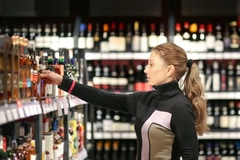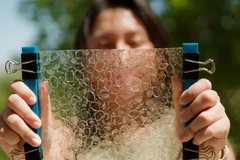Packaging color saturation shapes consumer perceptions of product efficacy, study finds
New research reveals that consumers associate more saturated packaging colors with higher product efficacy, highlighting how visual design elements can serve as an often subconscious influence in consumer decision-making.
The study, published in the Journal of Marketing, found that higher color saturation leads to stronger beliefs in a product’s potency. This effect extends beyond product color to include packaging and advertising backgrounds, and it influences both pre-purchase impressions and post-use evaluations.
Lauren Labrecque, a co-author of the study and professor of marketing at the University of Rhode Island, US, tells Packaging Insights: “Leaning toward more saturated colors on your packaging can be beneficial if you want to signal strength. However, this isn’t a one-size-fits-all recommendation. It’s crucial to align your color saturation with your product’s intended effect or consumption goal.”
“For products positioned as ‘strong’ or ‘potent,’ higher saturation on the packaging can reinforce that message and increase perceived efficacy and purchase intent. Conversely, for products intended to be ‘gentle,’ our research suggests that high saturation can actually decrease perceived efficacy and purchase intent. In such cases, opting for lower saturation levels might be more effective.”
 Higher color saturation leads consumers to infer greater product potency.Labrecque says marketers should be mindful of consumers’ tendency to overgeneralize the link between color saturation and product efficacy. “Even if the product has no inherent color related to potency, this intuition can still influence efficacy perceptions.”
Higher color saturation leads consumers to infer greater product potency.Labrecque says marketers should be mindful of consumers’ tendency to overgeneralize the link between color saturation and product efficacy. “Even if the product has no inherent color related to potency, this intuition can still influence efficacy perceptions.”
Strategic color use
The research indicates that the visual cue affects consumer behavior, impacting purchase intent and the amount consumed.
“Strategically balancing color use across product lines with different intended effects hinges on understanding and leveraging the moderating effect of the consumption goal,” says Labrecque.
She provided examples showing that for products like cleaners or vitamins, higher color saturation in packaging can enhance perceived efficacy, whereas lower saturation is more suitable for gentler items such as sensitive skincare or mild detergents.
“It’s important to maintain a degree of visual coherence across the brand while differentiating product lines. This could involve using the same base hue but varying the saturation level to convey the intended effect. For example, a brand of cleaning products might use blue throughout its range, employing a highly saturated blue for its powerful cleaner and a less saturated blue for its more gentle cleaner.”
Preferences may also vary across different market regions. In Asia, for instance, there is a stronger focus on dopamine color palettes in cosmetics packaging design, which are perceived as more visually appealing.
Balancing aesthetics and functionality
Researchers caution that the perception of increased potency could have unintended consequences. While bold colors can make products more appealing, they might also mislead consumers about how the product should be used, which is especially concerning for items like medications or sanitizers. Proper use of color saturation can lead consumers to perceive a product as more aligned with their needs.
Proper use of color saturation can lead consumers to perceive a product as more aligned with their needs.
The study emphasizes that packaging design should balance aesthetics with functionality and trust. Designers need to ensure that visual elements align with the product’s intended use, particularly in categories where accuracy and safety are critical.
“Brands can consider using informational cues alongside color. If a highly saturated color is used for a product intended to be gentle, perhaps for brand recognition purposes, clearly communicating the ‘gentle’ aspect through text or other visual elements can help counteract the intuitive association with high potency,” Labrecque recommends.
“Conversely, if a less saturated color is used for a potent product, perhaps for a sustainable aesthetic, highlighting the potency with claims like ‘concentrated formula’ can reinforce its effectiveness.”
Role of design in e-commerce
Industry experts recognized that printing appropriate custom designs on boxes can help create stronger connections with consumers in e-commerce. Labrecque points out that digital environments have the potential to both amplify and, in some ways, distort the overgeneralization of color cues.
“In terms of amplification in e-commerce, consumers primarily interact with products through visual representations. They cannot touch, smell, or physically inspect the product. This heightened reliance on visual information makes aesthetic cues like color saturation even more salient in forming efficacy perceptions.”
.jpg) Consumers are likely to rely on visual heuristics in e-commerce, browsing through numerous products rapidly. “Moreover, e-commerce platforms often present products in a relatively standardized format with limited sensory input. This can make the readily available visual cues, such as the color of the product image and packaging, carry more weight in consumer judgment,” she continues.
Consumers are likely to rely on visual heuristics in e-commerce, browsing through numerous products rapidly. “Moreover, e-commerce platforms often present products in a relatively standardized format with limited sensory input. This can make the readily available visual cues, such as the color of the product image and packaging, carry more weight in consumer judgment,” she continues.
“Since online shopping environments often encourage quick decision-making, consumers may be more likely to rely on visual heuristics like this when browsing through numerous products rapidly. The lack of opportunity for deeper engagement and information processing can amplify the impact of these intuitive associations.”
However, there is also the potential for distortion, as Labrecque explains that differences in screen calibration and display settings across devices can affect how consumers perceive the actual color saturation and might “introduce noise into the intended signaling effect.”
“Additionally, the sheer volume of visual information online can sometimes lead to ‘visual fatigue,’ potentially diminishing the impact of any single cue, including color saturation,” says Labrecque.













